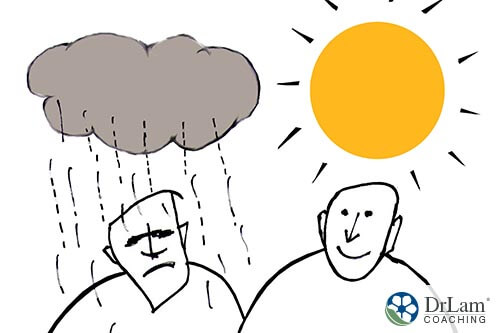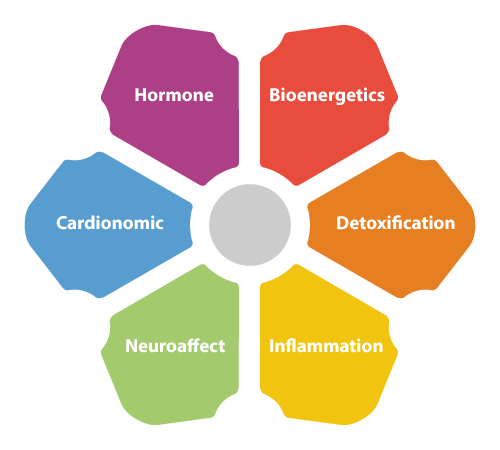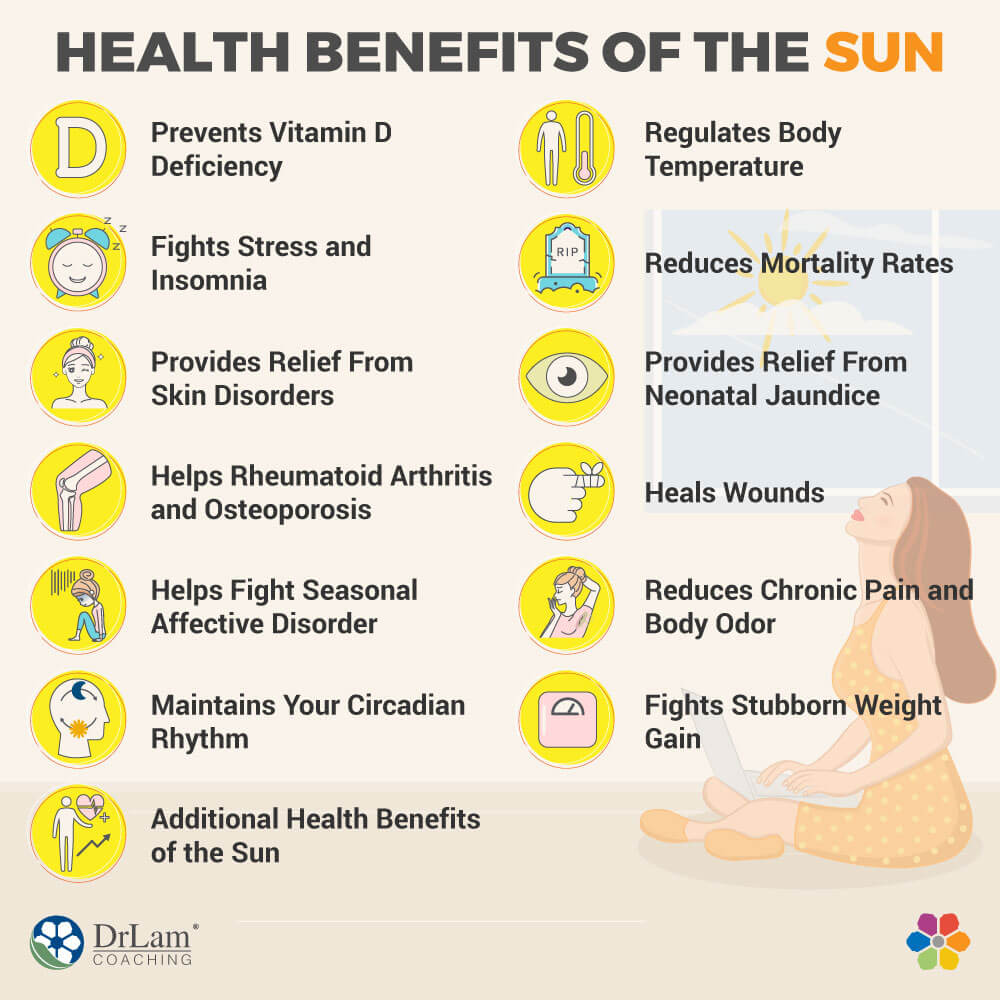 Modern beliefs tend to depict the sun in a bad light. We are often told to avoid direct sun exposure and always wear sunscreen before stepping outdoors. While it is true that some serious health concerns are linked to sun exposure including sunburn and melanoma, the underlying truth is that safe sun exposure can actually be therapeutic owing to some of the amazing health benefits of the sun. Furthermore, recent research shows that being exposed to too little sun exposure can reduce the survival rates of those suffering from certain diseases like cancer. As more people are recognizing the healing properties of sunlight, sun exposure therapy is gaining momentum.
Modern beliefs tend to depict the sun in a bad light. We are often told to avoid direct sun exposure and always wear sunscreen before stepping outdoors. While it is true that some serious health concerns are linked to sun exposure including sunburn and melanoma, the underlying truth is that safe sun exposure can actually be therapeutic owing to some of the amazing health benefits of the sun. Furthermore, recent research shows that being exposed to too little sun exposure can reduce the survival rates of those suffering from certain diseases like cancer. As more people are recognizing the healing properties of sunlight, sun exposure therapy is gaining momentum.
Throughout history, the sun has been respected in various cultures for its incredible curative powers. Thus, the health benefits of the sun have been known to mankind since ancient times. The sun is an integral part of Indian culture—the Vedas, an ancient sacred Hindu scripture, recognizes sun therapy as a powerful natural tool for healing health disorders. In fact, even today, people in India connect themselves with the sun through sacred practices, such as Surya Namaskar or Sun Salutation which is known to bestow physical, psychological, and spiritual healing benefits.
 Ancient Roman scholar Pliny viewed the sun as the most important natural self-administered medicine. Renowned physicians of Arabia and Rome, including Hippocrates, praised the natural healing power of heliotherapy—the use of natural sunlight to treat certain skin conditions. During the reign of the Roman Empire, sunlight therapy was used for correcting epilepsy, asthma, obesity, jaundice, and colon and bladder diseases. In the 1700s, sunlight was known to provide relief from rickets and scurvy. In the late 1800s, the recognized health benefits of the sun included correcting various bacterial infections such as dysentery, anthrax, and cholera. Renowned sunlight therapists Finsen and Koch received the noble prize in 1903 and 1905, respectively, for their unique treatment of tuberculosis with ultraviolet light.
Ancient Roman scholar Pliny viewed the sun as the most important natural self-administered medicine. Renowned physicians of Arabia and Rome, including Hippocrates, praised the natural healing power of heliotherapy—the use of natural sunlight to treat certain skin conditions. During the reign of the Roman Empire, sunlight therapy was used for correcting epilepsy, asthma, obesity, jaundice, and colon and bladder diseases. In the 1700s, sunlight was known to provide relief from rickets and scurvy. In the late 1800s, the recognized health benefits of the sun included correcting various bacterial infections such as dysentery, anthrax, and cholera. Renowned sunlight therapists Finsen and Koch received the noble prize in 1903 and 1905, respectively, for their unique treatment of tuberculosis with ultraviolet light.
In Switzerland, Dr Auguste Rollier used sun therapy for over 40 years to successfully treat tuberculosis. Out of a total of 2,167 patients, 1,746 were successfully treated with failures only associated with more advanced cases. In the early 1900s, several hospitals used Florence Nightingale to further enhance the therapeutic properties of sunlight. During the World War I, Dr. Oskar Bernhard utilized sun therapy to treat wounds and to prevent gangrene and tetanus. Eventually, the potential health benefits of the sun gained recognition.
Throughout the 1900s, sunlight therapy was used to treat various diseases of the nervous system, skin, circulatory system, musculoskeletal system, respiratory system, and circulatory system. However, since the discovery of antibiotics, such as penicillin, natural healing processes like sunlight therapy have slowly been replaced.
The advent of antibiotics and other medications have overshadowed natural healing procedures such as sunlight therapy. However, many people are now switching back to holistic therapies to avoid the adverse side effects of conventional medicine. The fear of sunlight began when people started to developed melanoma. Since then, direct sunlight exposure has been marketed in a bad light. In reality, unsafe sun practices are actually what causes melanoma.
In contrast, safe sunlight exposure can offer tremendous healing benefits. New research shows that not getting enough sun exposure can increase your chances of developing many health conditions, including vitamin D deficiency, skin cancer, heart disease, chronic pain, insomnia, and fatigue. Upon realizing the immense health benefits of the sun, sunlight therapy has now regained momentum and more people are choosing natural therapies to heal a variety of health conditions.
 Stress is the major contributing factor to disease. Your body responds to stress via the NeuroEndoMetabolic (NEM) stress response system, an intricate network of various organs and six circuits working in unison. Your adrenal glands—walnut-shaped glands located above your kidneys—are an important part of the NEM stress response. During stressful situations, the NEM stress response signals your adrenals to secrete the anti-stress hormone cortisol. However, if stress is constant and unrelenting, your adrenal glands will eventually become overburdened and will no longer be able to secrete adequate amounts of cortisol to meet demands. This decreases your body’s natural stress-fighting ability which can lead to adrenal fatigue. Frequently experiencing extreme fatigue along with other symptoms such as brain fog, insomnia, low energy levels, low concentration levels, constipation, stubborn weight gain, and cravings for salty and fatty foods could indicate Adrenal Fatigue Syndrome (AFS). Natural sunlight can have amazing health benefits and may help fight some of the symptoms associated with AFS.
Stress is the major contributing factor to disease. Your body responds to stress via the NeuroEndoMetabolic (NEM) stress response system, an intricate network of various organs and six circuits working in unison. Your adrenal glands—walnut-shaped glands located above your kidneys—are an important part of the NEM stress response. During stressful situations, the NEM stress response signals your adrenals to secrete the anti-stress hormone cortisol. However, if stress is constant and unrelenting, your adrenal glands will eventually become overburdened and will no longer be able to secrete adequate amounts of cortisol to meet demands. This decreases your body’s natural stress-fighting ability which can lead to adrenal fatigue. Frequently experiencing extreme fatigue along with other symptoms such as brain fog, insomnia, low energy levels, low concentration levels, constipation, stubborn weight gain, and cravings for salty and fatty foods could indicate Adrenal Fatigue Syndrome (AFS). Natural sunlight can have amazing health benefits and may help fight some of the symptoms associated with AFS.
Here is a list of some of the amazing powers of natural sunlight:
Vitamin D plays a vital role in maintaining strong bones and teeth, strengthens your immune system, and helps fight depression. Reduced sunlight exposure has been linked to vitamin D deficiency.
Lower levels of vitamin D could put you at a higher risk of developing osteoporosis, muscle weakness, depression, cancer, chronic pain, and autoimmune diseases. Only a handful of foods contain vitamin D, therefore, the best way to obtain this important vitamin is by exposing yourself to natural sunlight. Moderate sunlight exposure will help your body synthesize vitamin D.
If you suffer from AFS, you may have a disturbed sleep pattern, anxiety, depression, and a poor appetite. Serotonin plays a vital role in regulating sleep, appetite, and mood. Getting enough restorative sleep is essential to your recovery from adrenal fatigue. It’s time to set aside those chemical-laden antidepressants and give your body some natural sunshine. Moderate exposure to sunlight triggers serotonin production which, in turn, promotes better sleep, boosts your appetite, fights stress, and can improve your overall mood.
Natural sunlight is known to have amazing healing powers. Ultraviolet radiation from natural sunlight can provide relief from skin conditions such as eczema, psoriasis, acne, scleroderma, atopic dermatitis, and jaundice.
 Vitamin D deficiency is a major contributing factor to osteoporosis—an age-related disorder that leads to weak, brittle bones—and is also known to cause rheumatoid arthritis. In extreme cases, rheumatoid arthritis can be crippling. Studies have shown that an increase in the prevalence of rheumatoid arthritis at higher latitudes, where sunlight is minimal, compared to lower latitudes closer to the equator. Moreover, the severity of the disease worsens as the duration of sunlight exposure decreases.
Vitamin D deficiency is a major contributing factor to osteoporosis—an age-related disorder that leads to weak, brittle bones—and is also known to cause rheumatoid arthritis. In extreme cases, rheumatoid arthritis can be crippling. Studies have shown that an increase in the prevalence of rheumatoid arthritis at higher latitudes, where sunlight is minimal, compared to lower latitudes closer to the equator. Moreover, the severity of the disease worsens as the duration of sunlight exposure decreases.
Sunlight exposure triggers the synthesis of vitamin D in your body and promotes the absorption of phosphorus and calcium, essential for strengthening your bones and teeth. Sunlight can, therefore, provide mild relief from conditions such as rheumatoid arthritis, osteoporosis and also protects against high blood pressure, stroke, and heart attack.
Seasonal affective disorder (SAD) is a form of depression that tends to begin in early autumn and worsens in winter. The cause of the disorder is known to be sunlight and vitamin D deficiencies. Spending some time in the sun can provide relief from SAD by boosting your levels of vitamin D and serotonin—known as the happy hormone.
One of the important health benefits of the sun is that it is essential for maintaining your body’s circadian rhythm. Sunlight helps to balance your hormones—essential for your body and mind to function properly—thereby synchronizing your circadian rhythm. Furthermore, exposure to UV light triggers the production of melatonin, a powerful antioxidant that helps fight cancer.
Spending time outdoors in the sun can help regulate body temperature, reduce mortality rates, provide relief from neonatal jaundice, heal wounds, reduce chronic pain and body odour, and help fight stubborn weight gain. When natural sunlight strikes the retina, located at the back of your eye, it helps synchronize the important bio-rhythms of your body.

Natural sunlight is composed of over 1500 wavelengths but only the UVB rays possess curative powers. Time and duration of sun exposure are the two vital factors for successful sun therapy since excess sun exposure can cause additional health problems such as skin cancer. Healthy sun exposure can be achieved between 10 am and 2 pm when the UVB rays are optimal. Understanding how much sun exposure is required is also important especially if you’re suffering from the advanced stages of adrenal fatigue since your body may have temperature regulation issues and even short exposure to sunlight could trigger an adrenal crash. To avoid sunburn, quickly get out of the skin when your skin starts to turn light pink. To soothe your skin in the case of sunburn, consider applying a cold compress and aloe vera gel.
 The not-so-secret amazing curative powers of natural sunlight have been known to mankind since ancient times. Sunlight therapy has been practised throughout history for healing various health issues, owing to the immense health benefits of the sun.
The not-so-secret amazing curative powers of natural sunlight have been known to mankind since ancient times. Sunlight therapy has been practised throughout history for healing various health issues, owing to the immense health benefits of the sun.
Moderate sunlight exposure helps your body synthesize vitamin D, promotes absorption of phosphorus and calcium, boosts serotonin levels, helps fight stress, decreases insomnia, aids weight loss efforts, provides relief from rheumatoid arthritis and osteoporosis, fights SAD, helps maintain your circadian rhythm, regulates body temperature, reduces mortality rates, provides relief from neonatal jaundice, heals wounds, and reduces chronic pain. Following safe sun practices ensures you can take maximum advantage of the health benefits of the sun without causing any additional health issues.
© Copyright 2020 Michael Lam, M.D. All Rights Reserved.
The health benefits of the sun could prove useful in alleviating the symptoms of AFS. Moderate sun exposure under the guidance of an adrenal fatigue expert can provide relief from the symptoms of AFS including insomnia, anxiety, depression, stubborn weight gain, and low energy levels.
